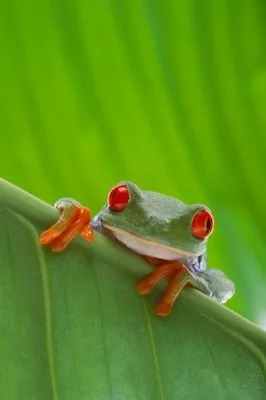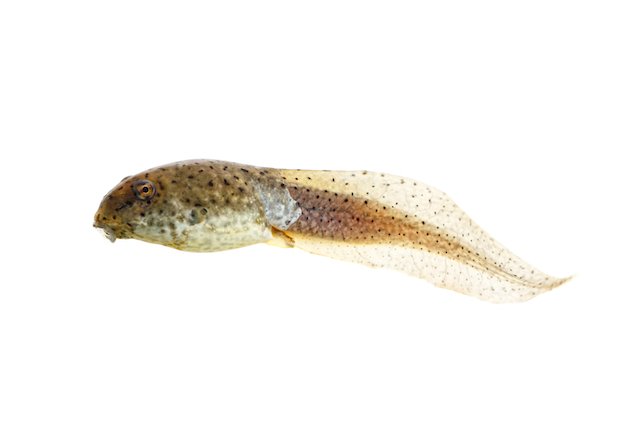Baby frogs are tadpoles.
They live in water when they hatch out of eggs.
After a while they grow legs and can come out of the water.
Frogs eat worms, tiny fish, and insects.
They use their long sticky tongue to catch food.
Frogs have big back legs to help them jump.
Frogs are amphibians (say am-fib-ee-uns). This means they live part of their life entirely in water and part of it on land and in water.
Tadpoles live entirely in water. ©Getty Images
The word amphibian comes from the Greek words 'amphi' which means both, and 'bios' which means life.
Amphibians are cold-blooded, which means their body temperature is the same as the temperature around them.
Adult frogs live on land and in water. ©Getty Images
For frogs that live where the winter temperatures are too cold, hibernation is the way they survive, buried in burrows or in mud at the bottom of a pond.
Frogs are found on every continent except Antarctica.
Body
Frogs have big back legs that let them leap a distance about 40 times their own body length. The front legs are short, and prop up the frog when it sits. They have webbed feet to help them swim.
A green tree frog ©Getty Images
Tree frogs have sticky pads on their feet that help them climb trees.
Frogs breathe through their skin as well as through their lungs. They have long sticky tongues that flip out fast to catch prey such as earthworms, tiny fish, and flying insects which it then pulls into its mouth. Frogs don't chew, but swallow prey whole.
Their bulging eyes let them see in many directions.
Frogs need water. They breed in water. In some dry places, frogs will breed and lay eggs in puddles as soon as it rains.
Frogs that live in desert areas burrow under the ground where the temperature is even, and as soon as it rains they wake up and breed while the water lasts.
Croaking frog. ©Getty Images
Frogs croak to attract a mate. Different kinds of frog have a different call. When they croak, skin on the throat swells up to help the sound travel further.
Frogs have different ways of protecting themselves against predators. Some are poisonous or taste bad, and have bright colours as a warning. Some puff up to look bigger.Most use camouflage as a defence.
A 'poison arrow' frog whose colours are a warning. ©Getty Images
The biggest frog is the African goliath frog , which grows to about 30cm in length. The smallest frogs are the Monte Iberia Eleuth in Cuba and the Brazilian golden frog. They are a bit less than 10 cm long.
Life Cycle
Frogspawn floating in a pond. ©Timescape -Dreamstime
Female frogs lay eggs in the water. This called frog spawn. A male frog fertilises the eggs so that tadpoles will form inside.
The eggs are surrounded with a clear jelly so they float, and stick to weeds to anchor them. Inside the jelly the egg develops.
A tadpole with back legs beginning to grow. ©Iamtkb-Dreamstime
A tadpole hatches from each egg. It swims about and grows bigger.
At about 6 weeks of age, the gills disappear and it starts to breathe through lungs.
Back legs develop at about 8 weeks.
At 12 weeks front legs appear and the tail begins to shrink.
Tadpoles with four legs. You can see the tail has begun to shrink. ©Sarah2-Dreamstime
As the tail shrinks, the legs grow bigger and begin to look like those of adult frogs.
When the tail is almost gone the tiny frog comes out of the water. The last bit of the tail disappears and the little frog, sometimes called a froglet, grows bigger. It becomes an adult.
Frog stages of development .©Getty
Australian frogs
All native Australian amphibians are frogs. There are about 200 species (or kinds) of frog known in Australia, possibly more to be discovered. Of these, some are presumed extinct, because none have been found for so long, some are Critically Endangered, Endangered, or Vulnerable.
Conservation and Threats
Frog populations all around the world as well as in Australia are getting smaller at an alarming rate.
Loss of habitat and pollution are a major threat to frogs. Frogs absorb air and water through their skin, so they are the first to be affected by a polluted environment - they are affected by pollution of water, land and air because they live on land and in the water. They are also affected by loss of habitat, particularly those species that live in very particular habitats, such as a specific mountain or swamp. Corroboree frogs are one example.
How can we help our threatened frogs?
When visiting national parks and other wild areas, take care not to damage habitats or pollute the environment. Make sure your visits are 'low impact', which means when you leave, it should be almost as if you had never been. This will help protect the habitats of all native species, not just frogs.
Don't pollute ponds. They are frog habitats. ©Getty Images
Help efforts to save threatened species in your local area: join organisations such as 'Friends of...' groups, or Landcare, or Australian Trust for Conservation Volunteers.
Join in special events such as 'Clean Up Australia', tree planting, weed eradication. This helps reduce pollution in their habitats.
Make a frog habitat
Make a frog habitat in your garden. Loss of habitat is a major threat to frogs. Making a 'frog bog' in the garden can help make a difference. Your frog bog needs shallow water and deeper water (at least 30cm deep) so that tadpoles can find cool spots. Altogether, you need at least 1 cubic metre of water at least so the tadpoles don't get crowded. Set it up in a partly shady spot so that sunlight can help algae grow in the water to feed the tadpoles.
Leaves from trees and shrubs nearby fall into the water, sink to the bottom and decompose, also providing food for tadpoles. Do not put floating plants like duckweed in the water because they can take oxygen out, making it hard for the tadpoles to breathe.
Adult frogs need shelter surrounding the pool: rocks, leaf litter, shrubs, low plants and logs.
Do not put fish in the pond: most eat tadpoles!
Keep cats out of the frog habitat: they eat frogs!
Don't spray the bugs: frogs eat them!
You won't need to catch frogs or tadpoles to put in the habitat (in some states this is illegal), as they may be the wrong species for your area. Frogs will find their own way to your frog friendly habitat.
It’s a good idea to get information from more than one source!
Read information to help you make a frog friendly environment and pond:
http://exoticpets.about.com/od/frogsandtoads/qt/frogsponds.htm
Find out about Australian frog species:
http://www.learnaboutwildlife.com/wildlifeAustraliaFrogs.html













